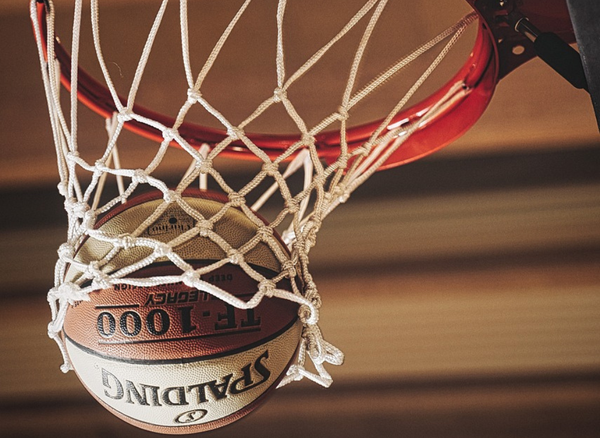Basketball is a team game that thrives on effective communication and the seamless transfer of the ball between players. Among the various skills that basketball players must master, passing stands out as a fundamental aspect that can dictate the flow and outcome of the game. The chest pass in basketball is a basic yet vital skill that every player should have in their arsenal. This article will delve into the intricacies of the chest pass and its variations, offering insights and practical advice to enhance your passing game.
The Fundamentals of the Chest Pass
The chest pass in basketball is a type of air pass that is essential for quick and accurate ball movement. It is called a chest pass because the pass originates from the chest level, making it a straight line pass that is easy for the receiver to catch.
The ball is held with two hands, fingers spread, and elbows slightly bent.
When ready to pass the ball, the player steps forward with their non-dominant foot, pushing the ball out from their chest towards the teammate. The arms fully extend in the direction of the pass, with the fingers pointing towards the target. This motion should be fluid and quick to minimize the chance of defenders intercepting the ball.
Variations of the Chest Pass
While the chest pass is a staple in basketball, players often need to use variations to adapt to different game situations. The overhead pass is used to throw the ball over a defender's head, while the behind the back pass adds an element of surprise, making it harder for the opponent to steal the ball. The bounce pass, where the ball is thrown to the ground so that it bounces up to the receiver, is effective in getting the ball past tight defenses.
Advanced passes like the baseball pass, which is a one-handed pass thrown with the same motion as a baseball throw, can cover long distances quickly. The dribble pass, where a player bounces the ball to themselves before passing, can be used to navigate through defenders. Each of these passes requires practice to master, as they involve different grips, release points, and timing.
The Role of Footwork in Passing
Footwork is crucial in basketball, not just for shooting and defense, but also for passing. The chest pass in basketball involves stepping forward to generate momentum. This step forward should be taken with the non-dominant foot to maintain balance and power. The feet should also be pointing in the direction of the pass to ensure accuracy.
Good footwork also helps in creating the necessary space to make a pass. By using pivots and quick steps, a player can maneuver around defenders and find a clear line to pass the ball. Coaches often emphasize footwork in drills because it improves a player's overall agility and effectiveness on the court.
Timing and Anticipation in Passing
Timing is everything when it comes to passing in basketball. A well-timed chest pass can lead to a successful jump shot or an easy layup. Players must learn to anticipate their teammate's movements and be ready to pass the ball at the right moment. This requires a strong understanding of the game and constant communication on the court.
Anticipation also involves reading the defense and recognizing when a passing lane is open. Players must watch for cues from defenders and be prepared to release the ball quickly before the window of opportunity closes. This skill becomes more refined with experience and is what separates good passers from great ones.
Passing Drills for Improvement
To improve passing skills, players should engage in various drills that focus on accuracy, speed, and decision-making. A simple drill for the chest pass involves two players standing a distance apart and passing the ball back and forth, aiming for the chest area. To add complexity, players can incorporate movement, passing while jogging or sprinting up and down the court.
Another effective drill is the three-man weave, which involves three players weaving in and out while passing the ball to each other without letting it touch the ground. This drill enhances coordination, timing, and helps players get a feel for the speed and direction of their passes.
Incorporating Passes into Game Play
Understanding when and how to use different passes during a game is critical. The chest pass is used to quickly swing the ball around the perimeter. Bounce passes are ideal for entry passes into the post, while overhead passes can be effective against taller defenders.
Players should also be aware of their position on the court. For instance, an outlet pass is typically thrown by a rebounder to a teammate further up the court to initiate a fast break. Knowing the context and choosing the right pass can lead to more successful plays and ultimately, more points on the scoreboard.
Common Mistakes to Avoid
One of the most common mistakes in passing is telegraphing the pass, which occurs when a player makes it obvious where they are going to throw the ball, allowing defenders to react and potentially steal the ball. Players should also avoid passing too softly or too hard, as this can make it difficult for the receiver to catch the ball.
Another mistake is not following through with the pass. After releasing the ball, the passer's arms should extend towards the target, and fingers should be pointing in the direction of the pass. This ensures that the ball travels in a straight line and reaches the teammate accurately.
The Psychological Aspect of Passing
Confidence and trust are key psychological components of passing. Players must have confidence in their ability to make the pass and trust that their teammate will catch it. Hesitation can lead to turnovers, so it's important for players to be decisive with their passing.
Building chemistry with teammates also enhances the passing game. When players are familiar with each other's tendencies and movements, they can anticipate where their teammates will be and deliver the pass accordingly. This level of understanding often comes with time and practice.
The Impact of Passing on Team Dynamics
Passing is not just a physical skill; it's a way to foster teamwork and unity. A team that passes well is often a team that communicates well and supports each other on the court. Sharing the ball through effective passing can lead to a more balanced offense and ensure that all players are involved in the game.
Coaches often stress the importance of passing because it can dictate the tempo of the game and break down defenses. A team that masters the art of passing can control the game and create scoring opportunities that might not be possible through individual play.
FAQ Section
Are you tired of struggling to improve your basketball passing game? Many players struggle with proper passing techniques and often end up turning the ball over or making inaccurate passes. We hope our Frequently Asked Questions section can help you discover some new tips and tricks.
Why is the chest pass considered a fundamental skill in basketball?
The chest pass is fundamental because it is a quick, accurate, and versatile way to move the ball between players. It is easier to catch and control than other passes, making it a reliable option in various game situations.
How can I improve my chest pass in basketball?
To improve your chest pass, practice the fundamentals of stepping forward with your non-dominant foot, extending your arms, and following through with your fingers pointing towards the target. Engage in passing drills, work on your footwork and timing, and play in game-like scenarios to refine your skills.
What are some common mistakes to avoid when making a chest pass?
Common mistakes include telegraphing the pass, passing too softly or too hard, not following through, and hesitating. To avoid these, work on being decisive, maintaining a firm grip, and practicing your passing technique regularly.
Summary
The chest pass in basketball is a fundamental skill that every player should master. It allows for quick, accurate, and efficient ball movement, which is essential for successful team play. By understanding the mechanics of the chest pass and its variations, practicing footwork and timing, and incorporating these skills into game situations, players can significantly improve their passing abilities. Remember to avoid common mistakes, build confidence and trust with teammates, and recognize the impact of passing on team dynamics.









